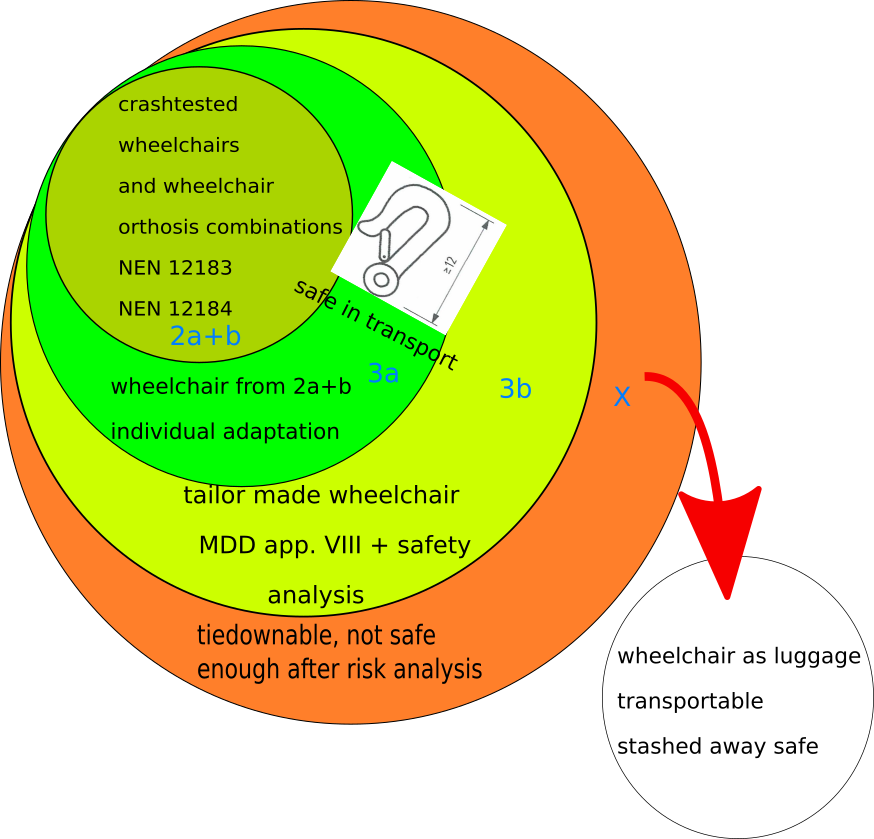This post is also available in: Nederlands (Dutch)
Musketon hook label

For a driver, it is sometimes difficult to identify where he has to attach the 4-point locking system (ISO 10542) to a wheelchair. The manufacturer of a safely transportable wheelchair has stuck the hook symbol at those places. The manufacturer states in his product information that the wheelchair is suitable as a seat during the ride.
Peeking at the neighbors
In Germany, a round table discussions with many parties from all sections of transport is held from 2008 onwards. This resulted in a number of position papers, including this possible solution direction of the Verband derTüv .
The Tüv distinguishes (in summary) multiple transport solutions for wheelchair users divided into the following categories:
1. The vehicle seat as a seat,
where this is not possible,
2. a standard wheelchair (which meets EN 12183 or EN 12184),
where a standard wheelchair does not fit,
3a. use an individually adapted wheelchair where a standard wheelchair from point 2 serves as a base,
where an individually adapted wheelchair is not sufficient,
3b. use a fully customized wheelchair, where the manufacturer complies with the MDD Annex VIII section 2, using standards EN 12183 or EN12184 and the wheelchair is assessed for responsible safety in wheelchair transport.
The tie-down system, which secures category 2 and 3 wheelchairs, must comply with DIN 75078-2 (in the Netherlands ISO 10542).
Above all, read the entire text for problem-setting and proposed solution.
Tie down points
In order to be able to transport a wheelchair, the tie-down points must be recognisable. Therefore, the ISO 7176/19 standard requires that the fastening points be marked with locking hook labels. When performing a crash test, a wheelchair is also attached to these points.
According to the standard, wheelchairs suitable for category 1 transport (standard wheelchair) and also the category 2 (individually modified standard wheelchair) must be fitted by the manufacturer with the tie-down hook labels.
The manufacturer/wheelchair adjuster indicates the suitability of a custom wheelchair as a seat during the ride. For the manufacturer/wheelchair adjuster’s regulation, he can also attach the relevant tie down hook label to the 4 tie-down points on the wheelchair.
A wheelchair passport states the suitability of the wheelchair as a seat and any additional points of attention.
Summed up as a proposal:

It is important that a choice is made during the provision of the wheelchair which falls into the three green areas. Then the group of unsafe wheelchairs in transport will automatically become smaller. It can also be decided to look up this group of wheelchairs in a targeted way. However, the wheelchair user is not the only one responsible for the replacement with a wheelchair from the green group! see DVfr position among others
‘Liability in the transport of wheelchair occupants in accessible vehicles should not be passed on to users of wheelchairs and scooters or to the drivers of the vehicles, as they have little impact on the technical performance of wheelchairs and of locking systems in the vehicles.’ (translated from German.)
“Haftungsrisiken bei der Beförderung in öffentlichen Verkehrsmitteln dürfen weder auf die Nutze-rinnen und Nutzer von Rollstühlen oder Scootern noch auf die Kfz-Fahrerinnen und -Fahrer verlagert werden, denn diese haben kaum Einfluss auf die technische Ausstattung der Rollstuhl- und Personensicherung in Verkehrsmitteln.”
A safe wheelchair in the current situation does not mean that transport is completely without risk. First, that is impossible, everyone runs a certain risk on the road. Secondly, a wheelchair is still not a fixed vehicle seat, for which heavier safety requirements apply. This too will need to be more attentive in the future.
Social choice
The level of security that we consider acceptable, we choose together as a society. As well as ensuring a free choice of mobility aids and from the various transport options. The UN Convention on Rights for People with Disabilities is guiding.
This choice requires an open discussion, involving all parties including the government. So that the restrictive attitude of some parties is not decisive.
Perhaps it is possible to join the discussion that has already taken place in Germany? Surely free movement between and in EU countries also applies to wheelchair users?
According to the BGW :
“If an individually manufactured or specially adapted wheelchair is required or special accessories are attached to the wheelchair, a classic crash test is generally not possible. No proof of suitability as a vehicle seat can currently be issued for such devices. A dilemma for wheelchair users and transport providers: the first ones want and need to be mobile, the latter need legal certainty for safe transport. A round table currently being worked on by the Bundesministerium für arbeit und Soziales to solve this problem – namely, to create binding rules. The BGW is represented at this round table. (translated from German.)”
In the Netherlands, I believe that the legislation stands in my way, although I am not a lawyer, currently “suitability as a vehicle seat” does not get in the way, provided that it can be shown that has been complied with art. 59.4 RVV:
“These passengers are transported in a wheelchair that is secured in the vehicle in a manner that ensures the stability of the wheelchair and the safety of the wheelchair user. ….. ”
I like to participate in the open discussion.
Linked to
Haven’t we forgotten somebody?
Risk and risk analysis when choosing a wheelchair.
Rijdende Rechter (travel judge)
